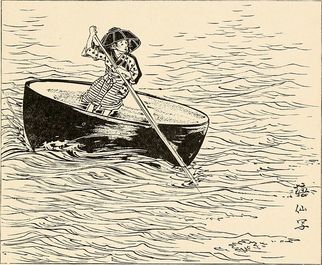|
Issun Boshi is interesting because it’s such a unique variant of the Thumbling story, clearly native to Japan. Many others are simply the same story given different window dressing. Here, though, Issun Boshi’s narrative is fundamentally different. And Issun-Boshi shows up multiple times under different names (like Mamesuke), which I think is enough to establish it as its own variation.
The typical thumbling is a trickster and child-archetype with simple, even repetitive adventures and a circular narrative. Thumbling’s Travels is one example – although by age he’s a young adult and ready to go out into the world and make a living, by the end he’s back at home with his parents, still technically a child. Issun Boshi’s story, however, is of a boy growing into a man. The common elements are very interesting. The wish for a child: yes Emphasis on small size, creative use of objects (like a needle for a sword): yes Helping on the farm: no Tricking people: no Being swallowed: Yes, but in a typical thumbling story, it’s just one of those wacky things that happens when you’re an inch tall. The thumbling is a passive agent and must be rescued. In Issun-Boshi, it’s a battle to defend his princess. Finally, instead of remaining small all his life, Issun Boshi grows to full size, symbolically becoming an adult. Issun Boshi may have been recorded even before Tom Thumb. It’s one of the otogi-zoshi – a later term for popular stories written mostly in the Muromachi period from 1392 to 1573. It may have not become widespread until the early Edo period. Frustratingly, that’s a pretty big window of time, and I haven’t been able to find anything to narrow that down. Most early manuscripts have no dates and the identities of their authors are also a mystery. The copies that do have dates are usually retellings or copies from the Edo period. Haruo Shirane mentions that the oldest versions of Issun Boshi “[survive] in a mere three manuscripts” but doesn’t say which they are, and his source for this is presumably in Japanese, rendering it inaccessible to me for now. Issun Bôshi means “One Sun Boy” – a “sun” being equal to just over an inch. Thus, in English, he is sometimes renamed some variation on Little One-Inch. Unlike European tales, which tend to place stories in vague locations, it is very specific. Issun Boshi is born after his parents pray at Sumiyoshi sanjin, an ancient Shinto shrine in Osaka. He travels across Osaka Bay in a rice bowl and has an adventure in Kyoto. The Yanagita Guide to the Japanese Folk Tale lists multiple variants of this story under different names, such as Issunbo or Issun Kotaro. More distantly related, Virginia Skord mentions eleven otogi-zoshi tales about a dwarf hero winning a wife and climbing in social status. Issun Boshi is one category. The other two categories are Ko Otoko (Little Man) and Hikyūdono (Lord Dwarf). Ko Otoko, with its one-foot-tall hero Toshihisa, has a near-identical plotline to Lazy Taro. He eventually becomes the god of Gojo Shrine and his wife becomes Kannon, a goddess of childrearing who is Buddhist in origin. (Incidentally, Issun-Boshi’s princess is attacked while on her way to pray at Kannon’s shrine.) The story of Hikyūdono is a cross between Issun Boshi and Ko Otoko, but I haven’t been able to find more information on it yet. This story is probably one of the more well-known thumbling tales, and I think that from a storytelling standpoint, it may be better than the typical Thumbling. Sources
Text copyright © Writing in Margins, All Rights Reserved
3 Comments
hlcd
10/29/2018 05:28:23 pm
hi I want to know how issun-boshi familiar to Tom thumb.....
Reply
Writing in Margins
10/29/2018 09:17:57 pm
They're both fairytales about tiny people who become warriors. Other than that, I touched on some of the similarities in other blog posts, like this one: https://writinginmargins.weebly.com/home/thumblings-and-royalty
Reply
6/13/2020 04:32:30 am
Hello,
Reply
Leave a Reply. |
About
Researching folktales and fairies, with a focus on common tale types. Archives
July 2024
Categories
All
|
Writing in Margins

 RSS Feed
RSS Feed
